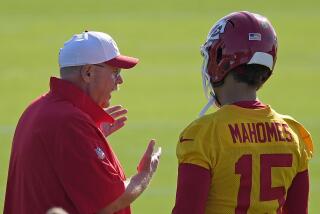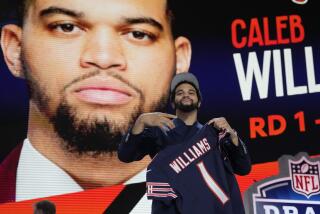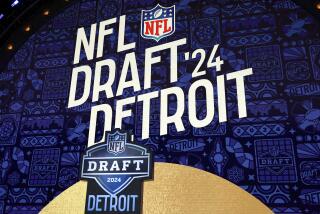Drafting a quarterback gets more complicated
Reporting from Indianapolis â When it comes to this yearâs crop of NFL quarterback hopefuls, itâs vital to know how well they think and throw and lead. But interested teams also want to know something equally important:
How well do these guys scramble?
Thatâs not just a reference to the way a quarterback moves, but how he will cope with a potential mad scramble to get up and running in what could be a very compressed preseason.
Because of the uncertain labor situation, no one knows if teams will have anything close to a normal preparation period for the 2011 season. If thereâs a lockout, for instance, coaches wonât be able to work with their players until there is a resolution. That could mean a rookie quarterback wouldnât get a playbook, let alone a practice session, until deep into the summer or even later. Good luck getting him up to speed if thatâs the case.
All that has added a layer of difficulty to the leagueâs scouting combine, which began Thursday at Lucas Oil Stadium and runs through Tuesday. Itâs early in the evaluation process, but the top four prospects on most draft boards are Auburnâs Cam Newton â the potential No. 1 pick â Missouriâs Blaine Gabbert, Washingtonâs Jake Locker, and Arkansasâ Ryan Mallett, typically in that order.
Many of the prospects, and most notably Newton, played in spread offenses in which they seldom, if ever, operated under center. That makes it more difficult to judge how they will transition to the pros.
âItâs not just your cut-and-dried, pro style of quarterbacks in this draft,â said Buffalo Coach Chan Gailey, whose team picks third and is looking for a quarterback. âSo youâre projecting a little bit more maybe than we have in years past on this group.â
Make no mistake, a lot of teams will be forced into making that leap of faith. Of the teams drafting in the top 10, only Denver (second), Cleveland (sixth) and Dallas (ninth) have their quarterback situations solidified.
Those teams still searching can take solace in the recent trend of success when it comes to evaluating top quarterback prospects. For decades, that has been the leagueâs most inexact science, resulting in millions of dollars blown on players such as Ryan Leaf, Alex Smith, Matt Leinart, Brady Quinn and JaMarcus Russell.
But in the past three seasons, almost all of the quarterbacks drafted in the opening round have panned out: Matt Ryan (Atlanta) and Joe Flacco (Baltimore) in 2008; Mark Sanchez (New York Jets) and Josh Freeman (Tampa Bay) in 2009, and last season Sam Bradford (St. Louis). The possible exceptions are Detroitâs Matthew Stafford, who has been good but injury-prone, and Denverâs Tim Tebow, a project who has shown progress.
Newton said the success of Bradley, last seasonâs offensive rookie of the year, should help convince scouts a player can make the transition from a spread to pro-style offense.
âIâm saying this kind of in a joking way, but I think an option quarterback can be successful in the NFL if heâs willing to make that transition a full one,â he said in a phone interview. âYou have to be a chameleon and adapt to your environment.â
Carolina Coach Ron Rivera said the Panthers will be taking a hard look at the field of soon-to-be-rookie quarterbacks, even though the team used a second-round pick on Notre Dameâs Jimmy Clausen last season.
âWe have to have a franchise quarterback to lead your team for the next six, seven, eight years,â Rivera said. âDo you have to take that guy or is he on our roster right now? Thatâs all part of our evaluation process. There are eight, nine 10 guys weâre looking at and we have to explore all avenues with everybody.â
In a normal year, the draft would be one of the last places to address the need for a quarterback, with the first being free agency or a trade.
If the NFL and the playersâ union were to let the collective bargaining agreement expire March 3, however, free agency would be put on hold, and teams would not be able to trade players, only draft picks. (There will still be a draft, April 28-30.) That would ratchet up the pressure to make the right pick from this college class.
Gailey said teams will want to know of the young quarterbacks: âHow are they going to react? How are they going to be able to handle that? You can handle it in shorts. But can you handle it when thereâs big guys on the other side about two yards away coming at you?â
Because, in this strange time of uncertainty, being a running quarterback is one thing. Being an up-and-running quarterback is another.
twitter.com/latimesfarmer
More to Read
Go beyond the scoreboard
Get the latest on L.A.'s teams in the daily Sports Report newsletter.
You may occasionally receive promotional content from the Los Angeles Times.











